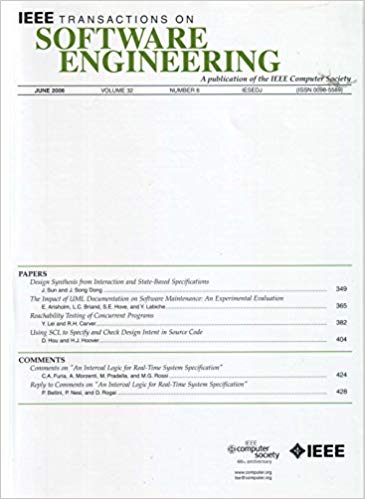利用轨迹对齐测量物理孪生体和数字孪生体的保真度
IF 6.5
1区 计算机科学
Q1 COMPUTER SCIENCE, SOFTWARE ENGINEERING
引用次数: 0
摘要
数字孪生在许多领域越来越重要,以改善复杂系统的操作和维护。尽管它们很重要,但目前大多数工作都集中在它们的设计、开发和部署上,而没有完全解决它们的验证问题。在本文中,我们感兴趣的是评估物理和数字双胞胎的保真度,更具体地说,他们是否表现出双胞胎的行为。这将允许工程师检查数字双胞胎是否适合其预期用途。我们的方法是通过比较两个双胞胎的行为轨迹来评估他们的忠诚度。我们的贡献是三重的。首先,我们定义了单个快照之间的等价度量,能够决定两个快照是否足够相似。其次,我们使用跟踪对齐算法来对齐两个双胞胎达到的相应等效状态。最后,我们根据匹配快照的百分比和对齐轨迹之间的距离实现的对齐水平来测量两个双胞胎行为的保真度。我们的提议已经通过四个网络物理系统的数字双胞胎得到了验证:电梯、孵化器、机械臂和可编程机器人汽车。我们能够确定哪些系统是足够可靠的,哪些部分的行为无法模仿它们的对应系统。最后,我们将我们的建议与文献中的类似方法进行了比较,突出了各自的优点和与我们自己的方法相关的缺点。本文章由计算机程序翻译,如有差异,请以英文原文为准。
Measuring the Fidelity of a Physical and a Digital Twin Using Trace Alignments
Digital twins are gaining relevance in many domains to improve the operation and maintenance of complex systems. Despite their importance, most efforts are currently focused on their design, development, and deployment but do not fully address their validation. In this paper, we are interested in assessing the fidelity of physical and digital twins and, more specifically, whether they exhibit twinned behaviors. This will allow engineers to check the suitability of the digital twin for its intended purpose. Our approach assesses their fidelity by comparing the behavioral traces of the two twins. Our contribution is threefold. First, we define a measure of equivalence between individual snapshots capable of deciding whether two snapshots are sufficiently similar. Second, we use a trace alignment algorithm to align the corresponding equivalent states reached by the two twins. Finally, we measure the fidelity of the behavior of the two twins using the level of alignment achieved in terms of the percentage of matched snapshots and the distance between the aligned traces. Our proposal has been validated with the digital twins of four cyber-physical systems: an elevator, an incubator, a robotic arm, and a programmable robotic car. We were able to determine which systems were sufficiently faithful and which parts of their behavior failed to emulate their counterparts. Finally, we compared our proposal with similar approaches from the literature, highlighting their respective strengths and weaknesses related to our own.
求助全文
通过发布文献求助,成功后即可免费获取论文全文。
去求助
来源期刊

IEEE Transactions on Software Engineering
工程技术-工程:电子与电气
CiteScore
9.70
自引率
10.80%
发文量
724
审稿时长
6 months
期刊介绍:
IEEE Transactions on Software Engineering seeks contributions comprising well-defined theoretical results and empirical studies with potential impacts on software construction, analysis, or management. The scope of this Transactions extends from fundamental mechanisms to the development of principles and their application in specific environments. Specific topic areas include:
a) Development and maintenance methods and models: Techniques and principles for specifying, designing, and implementing software systems, encompassing notations and process models.
b) Assessment methods: Software tests, validation, reliability models, test and diagnosis procedures, software redundancy, design for error control, and measurements and evaluation of process and product aspects.
c) Software project management: Productivity factors, cost models, schedule and organizational issues, and standards.
d) Tools and environments: Specific tools, integrated tool environments, associated architectures, databases, and parallel and distributed processing issues.
e) System issues: Hardware-software trade-offs.
f) State-of-the-art surveys: Syntheses and comprehensive reviews of the historical development within specific areas of interest.
 求助内容:
求助内容: 应助结果提醒方式:
应助结果提醒方式:


